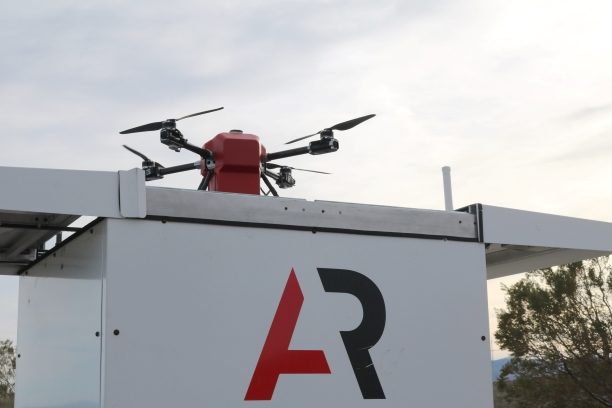

At the Commercial UAV Expo, industry leaders gathered to discuss how the drone industry can accelerate its growth and achieve commercial viability. Moderated by Gretchen West, co-founder of the Commercial Drone Alliance, the panel featured insights from Eric Brock, CEO of Ondas Holdings, Jon Damush, CEO of uAvionix, and Eric Mintz, Director of Infrastructure Mobility at Mitsubishi Electric. All of the panelists are veterans of navigating the complex economomics of business in cutting edge industries: balancing development in tough investment environments and navigating a viable path to profitability. The conversation focused on the steps needed for the industry to scale, attract investment, and prepare for the future in a post-regulation environment.
A Post-Regulation Perspective: Moving Beyond Technical Challenges
Eric Brock kicked off the discussion by emphasizing the need for reflection on the industry’s current state. While the rapid advancement of technology and evolving policies are encouraging, Brock highlighted the importance of shifting focus from innovation to operationalization. Ondas Holdings is the parent company of drone manufacturer American Robotics, Airobotics, cUAS provider Iron Dome and software provider Ardenna.
“We talk about our technical challenges and evolving policy, but we don’t reflect enough on how we are growing,” said Brock. “Technology has evolved quickly, and policies are hardening. Now, the question is: how do we operationalize this at scale? That’s going to require collaboration from everyone in this room.”
For Brock, the next stage of the drone industry’s evolution is about making sure that the technology is fully operational and scalable. Achieving this will require cooperation.
The Gartner Hype Cycle: Moving Through the Trough of Disillusionment
Jon Damush brought up the Gartner Hype Cycle, a model that tracks the rise of new technologies through the peaks and valleys of market expectations. According to Damush, the drone industry is currently at the bottom of the “trough of disillusionment,” a period of recalibration after early hype and inflated expectations.
“There has never been ambiguity that our industry was going to be large,” Damush explained. “The question has always been when. I’m particularly bullish about where this industry is headed, but I think it’s going to be less exciting—and that’s our job. When you get to the point where it’s boring, reliable, predictable, and safe, that’s when you have a big business.”
Damush’s perspective suggests that while the industry may be transitioning away from the excitement of early innovation, this shift toward reliability and safety is a critical step toward true commercialization and widespread adoption.
Drones as the “Flying PC”: A Path to Democratization
Eric Mintz expanded on the idea of drones being a revolutionary technology, drawing a parallel between drones and the personal computer industry. He emphasized that just as personal computers democratized computing, drones have the potential to democratize flight.
Mintz credits this idea to Jon Damush. “Jon told me, ‘drones are a way of democratizing flight,’ and that’s really profound,” said Mintz. “When you deconstruct our industry from its inception, it doesn’t just resemble the personal computer industry—it’s identical.”
Mintz explained that the drone industry may be on the verge of its “internet moment,” a pivotal period when a new technology not yet fully revealed or widely adopted leverages existing technologies to transform the market. Much like how the internet unlocked the full potential of personal computers, connecting them and fundamentally changing the way the world operates, drones could similarly experience this kind of transformation. Mintz pointed out that as the commercial sector continues to evolve across hardware, software, and services, repurposing existing infrastructure – as may be needed for advanced air mobility – might be the key to realizing this moment.
While PCs eventually became commodotized, Mintz doesn’t see the same result for the drone industry. He believes that while recreational drones have faced commoditization, commercial drones will follow a different path due to the complexity and specialization of their applications.
“Our ‘internet moment’ is coming,” Mintz said.
Preparing for the Future: Building Sustainable Business Models
The panel also touched on how companies in the drone industry should be thinking about their future business models. Gretchen West pointed out that the industry is still too small to wield significant lobbying power, making it critical for companies to be strategic about their growth.
While Eric Brock says that drones are inherently profitable, he stressed the importance of integrating technologies and building infrastructure to support scalability. “It’s not about just showing up with a drone,” Brock said. “It’s how you integrate technologies.”
Damush echoed this sentiment, highlighting the need for product-market fit. “We’ve solved the issues of flight,” he said. “But that’s not product-market fit—that’s just proving the prototype.”
Collaboration and Operationalization
As the panelists made clear, the drone industry is at a pivotal moment. While technical challenges have been addressed, the focus now shifts to scaling operations, finding product-market fit, and ensuring profitability. To achieve drone industry commercialization, the industry will need collaboration, strategic thinking, and the ability to integrate technologies into broader infrastructure systems. As these efforts mature, the drone industry will be positioned to move beyond the trough of disillusionment and into a future of reliable, predictable, and scalable operations. The “internet moment” of the drone industry may be just around the corner, waiting to fully transform the commercial sector.
Read more:
Miriam McNabb is the Editor-in-Chief of DRONELIFE and CEO of JobForDrones, a professional drone services marketplace, and a fascinated observer of the emerging drone industry and the regulatory environment for drones. Miriam has penned over 3,000 articles focused on the commercial drone space and is an international speaker and recognized figure in the industry. Miriam has a degree from the University of Chicago and over 20 years of experience in high tech sales and marketing for new technologies.
For drone industry consulting or writing, Email Miriam.
TWITTER:@spaldingbarker
Subscribe to DroneLife here.

